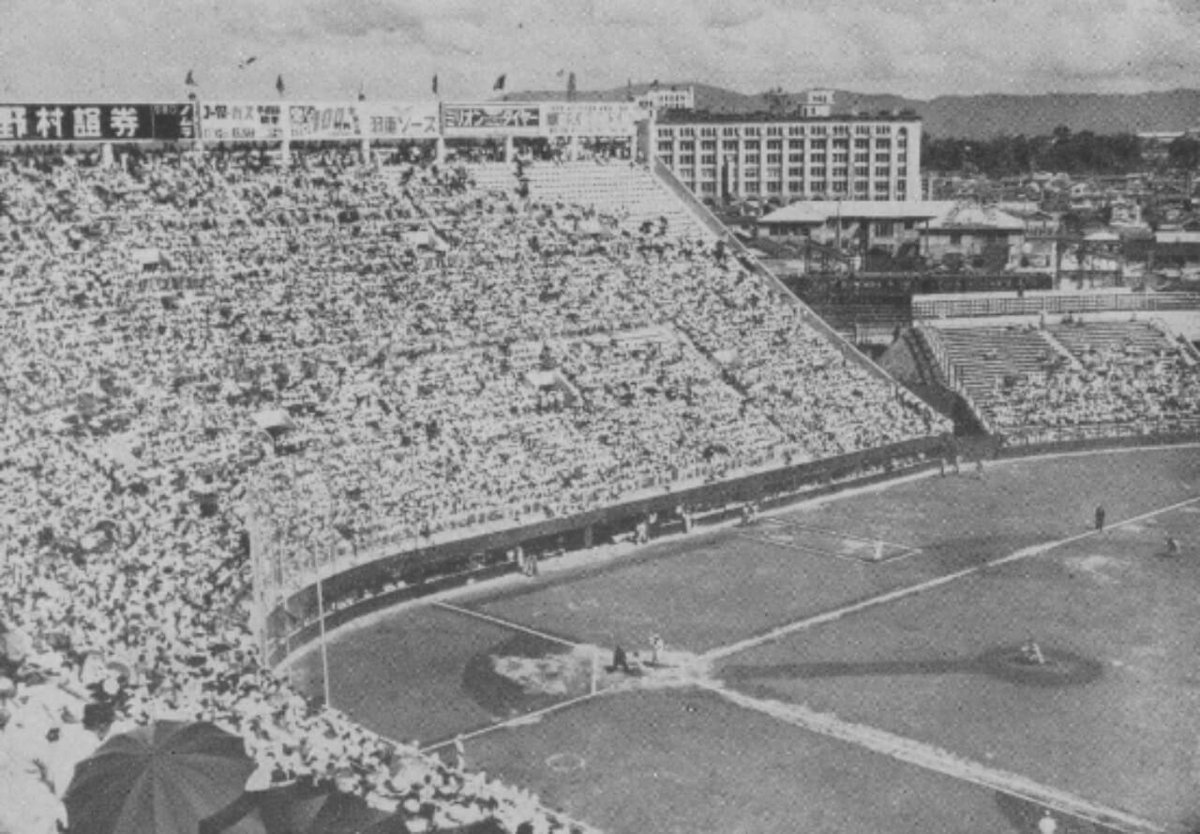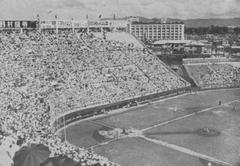
Osaka Stadium Visiting Hours, Tickets, and Guide to Kyocera Dome Osaka
Date: 14/06/2025
Introduction
Osaka, a city renowned for its vibrant blend of tradition and modernity, is home to two significant landmarks in the world of sports and entertainment: the historic Osaka Stadium—now the site of the innovative Namba Parks complex—and the cutting-edge Kyocera Dome Osaka. This guide provides detailed information on each location, including their history, current attractions, visiting hours, ticketing, and tips for making the most of your visit.
Whether you’re a baseball enthusiast, a concert-goer, or a cultural explorer, this article is your comprehensive resource for navigating these iconic Osaka destinations. We also highlight nearby attractions and offer practical advice to ensure an unforgettable experience. For real-time updates and event information, be sure to consult official sources and consider using the Audiala app.
Table of Contents
- Introduction
- History of Osaka Stadium
- Cultural Significance and Urban Evolution
- Visiting the Osaka Stadium Site: Namba Parks
- Kyocera Dome Osaka: Overview and Guide
- Major Events and Experiences at Kyocera Dome Osaka
- Visiting Hours, Tickets, and Entry Procedures
- Facilities, Amenities, and Accessibility
- Surrounding Attractions and Transportation
- Visitor Tips and Frequently Asked Questions
- Conclusion
- References and Further Reading
History of Osaka Stadium
Osaka Stadium (大阪球場) was constructed in 1950 in Naniwa-ku, Osaka, on the former grounds of a war-damaged tobacco plant. As one of the largest sports venues in western Japan at the time, it symbolized postwar recovery and served as the home field for the Nankai Hawks, a founding member of Nippon Professional Baseball (NPB), until 1988.
During its heyday, Osaka Stadium was not only a baseball mecca but also a beloved community hub. It hosted the Hawks’ championship runs, high school tournaments, and major international concerts, bringing together people from all walks of life. After the Hawks relocated to Fukuoka, the stadium briefly hosted other teams and events before closing its doors to professional baseball in 1990.
Cultural Significance and Urban Evolution
Beyond its role in sports, Osaka Stadium was a powerful symbol of civic pride. Positioned in the lively Namba district, it provided a gathering place where the community celebrated both local victories and global entertainment. The stadium famously hosted Madonna’s “Who’s That Girl” World Tour in 1987 and Michael Jackson’s “Bad World Tour,” cementing its reputation as a top entertainment venue.
In 1991, the stadium was repurposed for the “Namba Osaka Stadium Housing Fair,” transforming the playing field into a model residential neighborhood for an innovative housing expo. The stadium was eventually demolished in 1998, paving the way for the development of Namba Parks—a multi-level complex featuring terraced gardens, shopping, dining, and offices, completed in 2007. Today, Namba Parks stands as an exemplar of urban revitalization and green architecture, preserving the spirit of Osaka’s sporting heritage (Official Namba Parks Website; Osaka Official Tourism Guide).
Visiting the Osaka Stadium Site: Namba Parks
While Osaka Stadium no longer stands, its legacy is honored at Namba Parks, where visitors can enjoy:
- Location: 2-10-70 Nanbanaka, Naniwa-ku, Osaka
- Hours: Shops and restaurants generally open from 11:00 AM to 9:00 PM; garden areas accessible year-round
- Admission: Free entry to the park and public spaces; fees may apply for certain venues
- Accessibility: Directly accessible via Namba Station (multiple subway and rail lines)
- Nearby Attractions: Dotonbori, Shinsaibashi shopping arcade, Osaka Castle
Though there is no official memorial for Osaka Stadium on-site, the Namba Parks information center offers historical context. Sports fans can also explore nearby museums and other sports landmarks.
Photographic Tips:
Capture the lush terraced gardens and panoramic city views, and explore the vibrant Namba district for nightlife and street scenes.
Kyocera Dome Osaka: Overview and Guide
Introduction
Kyocera Dome Osaka (京セラドーム大阪) is a state-of-the-art, multipurpose stadium that opened in 1997. Known for its futuristic dome-shaped design and versatile event capabilities, it stands as a centerpiece of Osaka’s entertainment scene. The dome regularly hosts Orix Buffaloes baseball games, major concerts, exhibitions, and cultural events (Kyocera Dome Osaka Official Website; Klook).
Architectural Features
- Exterior: Distinctive spaceship-like dome with metallic panels and LED illumination
- Capacity: 36,477 for baseball; up to 55,000 for concerts and special events
- Facilities: Multiple seating tiers, luxury suites, accessible areas, extensive food and beverage outlets, merchandise shops, and family-friendly amenities
- Roof: Fixed dome with advanced HVAC systems for year-round comfort
- Accessibility: Elevators, ramps, and dedicated seating
Major Events and Experiences at Kyocera Dome Osaka
Sports
The Dome is the home field for the Orix Buffaloes and occasionally hosts Hanshin Tigers games. It also supports special sporting events like basketball and wrestling (National Stadium Tours).
Concerts and Cultural Events
Kyocera Dome regularly welcomes top international and Japanese artists, including Paul McCartney, BTS, Lady Gaga, and Madonna (Japan Concert Tickets). The venue also hosts exhibitions, anime conventions, and trade shows.
Annual Highlights
- X Games Osaka 2025: Premier action sports event (Japan Travel)
- Osaka Expo 2025: The Dome will host related entertainment and cultural activities (Espunis in Japan)
Visiting Hours, Tickets, and Entry Procedures
Hours
- Event Days: Gates open 1–2 hours before the event; check schedules on the official website
- Guided Tours: Offered on select days; advance booking recommended
Tickets
- Baseball and Concerts: Purchase via the official website, box office, convenience stores, or trusted travel agencies (Japan Experience; Japan Highlights)
- Prices: Vary by event; early booking advised for popular shows
Entry
- Security: All guests pass through security screening; translation apps can help with communication
- Prohibited Items: Large bags, outside food/drinks, certain devices—check event guidelines
Facilities, Amenities, and Accessibility
- Food: Local specialties and international cuisine; cashless payment preferred
- Restrooms: Ample, including accessible and family restrooms; nursing rooms available
- Merchandise: Official stores sell team gear and event souvenirs
- Wi-Fi: Free public Wi-Fi available in the Dome and nearby stations
- Luggage Storage: Coin lockers on-site and at nearby stations
Surrounding Attractions and Transportation
Access
- Location: 3-2-1 Chiyozaki, Nishi-ku, Osaka, 550-0023
- Trains: Dome-mae Station (Hanshin Namba Line), Dome-mae Chiyozaki Station (Osaka Metro), Taisho Station (JR Osaka Loop Line) (Matcha-JP)
- Bus and Taxi: Multiple routes; taxi stands nearby
- Parking: Available at the West Gate (less crowded), but public transportation is recommended
Nearby Attractions
- Dotonbori: Osaka’s famed entertainment and food district (Japan Specialist)
- Amerikamura: Youth culture and shopping
- Osaka Castle: Historic landmark
- Universal Studios Japan: Short train ride away
- Namba Parks: The former Osaka Stadium site, now a shopping and garden complex
Visitor Tips and Frequently Asked Questions
Tips
- Arrive Early: 60–90 minutes before events for smoother entry and seat selection
- Language: Use translation apps if needed; most signage is bilingual
- Payment: Credit cards, IC cards, and mobile payments preferred—cash is rarely accepted
- Weather: The Dome is fully covered—events proceed regardless of weather
- Umbrella Sharing: “Aikasa” service available at nearby stations (Live Japan)
FAQs
Q: Are guided tours available?
A: Yes, on select dates—check the official website for details.
Q: Is Kyocera Dome Osaka accessible?
A: Yes, with elevators, ramps, and accessible seating.
Q: Can I bring food or drinks?
A: Outside food/drinks are prohibited, but a wide range of options is available inside.
Q: What’s the best way to get to Kyocera Dome Osaka?
A: Public transportation is most convenient, especially during major events.
Q: What are some nearby attractions?
A: Dotonbori, Osaka Castle, Namba Parks, Universal Studios Japan, and more.
Conclusion
From the legacy of Osaka Stadium—now honored by the lush, urban landscape of Namba Parks—to the futuristic design and vibrant events at Kyocera Dome Osaka, these venues offer visitors a unique glimpse into Osaka’s sporting, cultural, and architectural heritage. Whether you’re attending a thrilling baseball game, a world-class concert, or simply exploring the city, Osaka’s stadiums are must-see destinations.
Plan ahead by booking tickets early, using public transportation, and exploring the surrounding neighborhoods for a well-rounded Osaka experience. Stay updated on the latest events and offers by checking official resources and downloading the Audiala app.
References and Further Reading
- Official Namba Parks Website
- Osaka Official Tourism Guide
- Kyocera Dome Osaka Official Website
- Klook
- National Stadium Tours
- Japan Concert Tickets
- Japan Experience
- Japan Highlights
- Japan Specialist
- Live Japan
- Matcha-JP
- Espunis in Japan
- Japan Travel
All information has been compiled and paraphrased from credible sources for accuracy and clarity.







































































